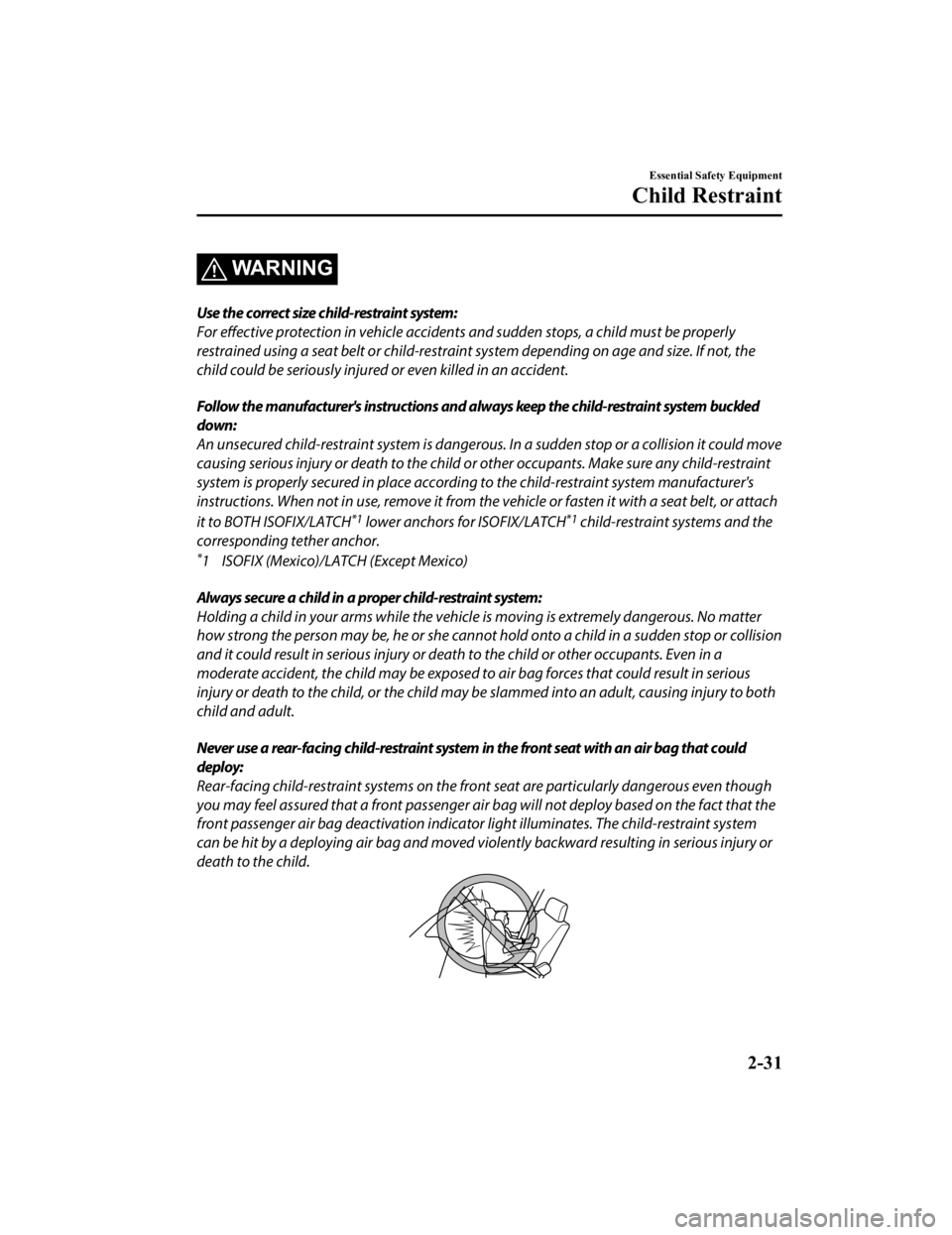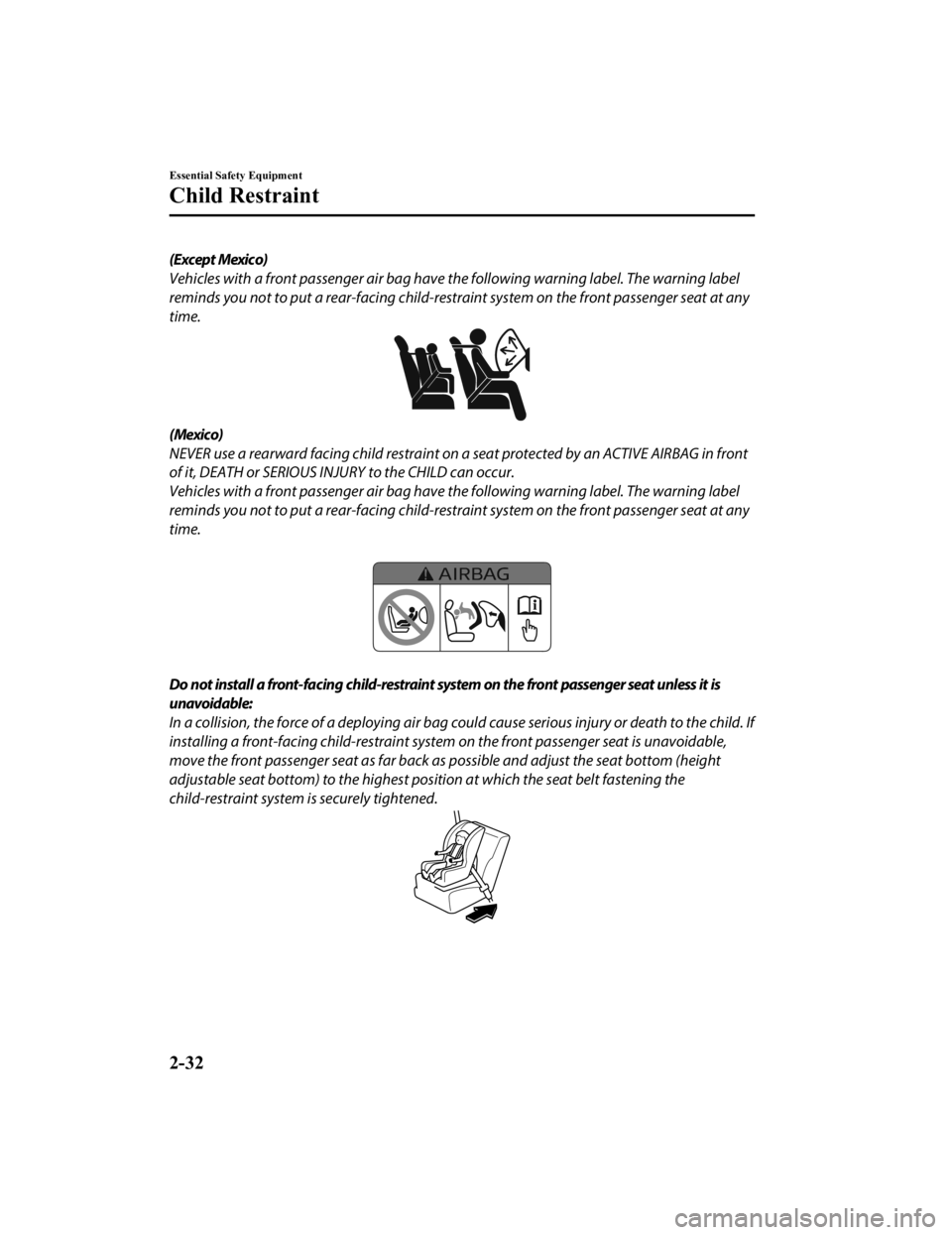warning MAZDA MODEL CX-3 2021 User Guide
[x] Cancel search | Manufacturer: MAZDA, Model Year: 2021, Model line: MODEL CX-3, Model: MAZDA MODEL CX-3 2021Pages: 618, PDF Size: 64.58 MB
Page 41 of 618

Do not leave a seat belt extender
connected to the buckle:
Leaving a seat belt extender connected to
the buckle without using the seat belt is
dangerous. When the seat belt extender is
connected to the driver's seat belt buckle
(or front passenger's seat belt buckle), the
SRS driver's (or front passenger's) air bag
system will determine that the driver (or
front passenger) is wearing the seat belt
even if the driver (or front passenger) is not
wearing it. This condition could cause the
driver's (or front passenger's) air bag to not
activate correctly and result in death or
serious injury in the event of collision.
Always wear the seat belt with the seat belt
extender.
Do not use the seat belt extender when
installing a child-restraint system on the
front or rear passenger seat:
Using a seat belt extender to fasten a
child-restraint system on any seat is
dangerous. Always follow the
child-restraint system manufacturer's
installation instructions and never use a
seat belt extender.
NOTE
When not in use, remove the seat belt
extender and store it in the vehicle. If the
seat belt extender is left connected, the
seat belt extender might get damaged as it
will not retract with the rest of the seat belt
and can easily fall out of the door when
not in use and be damaged. In addition,
the seat belt warning light will not
illuminate and function properly.
Essential Safety Equipment
Seat Belt Systems
2-29
CX-3_8JL1-EA-20G_Edition1_old2020-5-22 15:31:00
Page 43 of 618

WARNING
Use the correct size child-restraint system:
For effective protection in vehicle accidents and sudden stop s, a child must be properly
restrained using a seat belt or child-restraint system depending on age and size. If not, the
child could be seriously injured or even killed in an accident.
Follow the manufacturer's instructions and always keep the child-restraint system buckled
down:
An unsecured child-restraint system is dangerous . In a sudden stop or a collision it could move
causing serious injury or death to the child or other occupants. Make sure any child-restraint
system is properly secured in place accordin g to the child-restraint system manufacturer's
instructions. When not in use, remove it from the vehicle or fasten it with a seat belt, or attach
it to BOTH ISOFIX/LATCH
*1 lower anchors for ISOFIX/LATCH*1 child-restraint systems and the
corresponding tether anchor.
*1 ISOFIX (Mexico)/LATCH (Except Mexico)
Always secure a child in a proper child-restraint system:
Holding a child in your arms while the vehicl e is moving is extremely dangerous. No matter
how strong the person may be, he or she cannot hold onto a child in a sudden stop or collision
and it could result in serious injury or death to the child or other occupants. Even in a
moderate accident, the child may be exposed to air bag forces that could result in serious
injury or death to the child, or the child may be slammed into an adult, causing injury to both
child and adult.
Never use a rear-facing child-restraint system in the front seat with an air bag that could
deploy:
Rear-facing child-restraint systems on the front seat are particularly dangerous even though
you may feel assured that a front passenger air bag will not deploy based on the fact that the
front passenger air bag deactivation indicato r light illuminates. The child-restraint system
can be hit by a deploying air bag and moved viol ently backward resulting in serious injury or
death to the child.
Essential Safety Equipment
Child Restraint
2-31
CX-3_8JL1-EA-20G_Edition1_old 2020-5-22 15:31:00
Page 44 of 618

(Except Mexico)
Vehicles with a front passenger air bag have the following warning label. The warning label
reminds you not to put a rear-facing child-restra int system on the front passenger seat at any
time.
(Mexico)
NEVER use a rearward facing child restraint on a seat protected by an ACTIVE AIRBAG in front
of it, DEATH or SERIOUS INJURY to the CHILD can occur.
Vehicles with a front passenger air bag have th e following warning label. The warning label
reminds you not to put a rear-facing child-restra int system on the front passenger seat at any
time.
Do not install a front-facing child-restraint system on the front passenger seat unless it is
unavoidable:
In a collision, the force of a deploying air bag co uld cause serious injury or death to the child. If
installing a front-facing child-restraint system on the front passenger seat is unavoidable,
move the front passenger seat as far back as possible and adjust the seat bottom (height
adjustable seat bottom) to the highest posi tion at which the seat belt fastening the
child-restraint system is securely tightened.
Essential Safety Equipment
Child Restraint
2-32
CX-3_8JL1-EA-20G_Edition1_old 2020-5-22 15:31:00
Page 53 of 618

WARNING
Always attach the tether strap to the
correct tether anchor position:
Attaching the tether strap to the incorrect
tether anchor position is dangerous. In a
collision, the tether strap could come off
and loosen the child-restraint system. If the
child-restraint system moves it could result
in death or injury to the child.
Always remove the head restraint and
install child-restraint system:
Installing a child-restraint system without
removing the head restraint is dangerous.
The child-restraint system cannot be
installed correctly which may result in
death or injury to the child in a collision.
Tether strapForward
Tether strap
Forward
Always install the head restraint and adjust
it to the appropriate position after
removing the child-restraint system:
Driving with the head restraint removed is
dangerous as impact to the occupant's
head cannot be prevented during
emergency braking or in a collision, which
could result in a serious accident, injury or
death.
Refer to Head Restraints on page 2-17.
▼ Using Automatic Locking Mode
(Except Mexico)
Follow these instructions when using a
child-restraint system, unless you are
attaching a LATCH-equipped
child-restraint system
to the rear LATCH
lower anchors. Refer to “Using LATCH
Lower Anchor” (page 2-47).
NOTE
Follow the child-restraint system
manufacturer's instru ctions carefully. If
you are not sure whether you have a
LATCH system or tether, check in the
child-restraint system manufacturer's
instructions and follow them accordingly.
Depending on the type of child-restraint
system, it may use LATCH system instead
of seat belts or if the belt goes across the
child's chest, may recommend against
using automatic locking mode.
1. Make sure the seatback is securely latched by pushing it back until it is
fully locked.
2. Remove the head restraint. However,
when installing a backless booster seat,
always install the vehicle head restraint
to the seat where the backless booster
seat is installed.
Refer to Head Restraints on page 2-17.
Essential Safety Equipment
Child Restraint
2-41
CX-3_8JL1-EA-20G_Edition1_old 2020-5-22 15:31:00
Page 59 of 618

▼Using ISOFIX Lower Anchor (Mexico)
/Using LATCH Lower Anchor (Except
Mexico)
Your Mazda is equipped with ISOFIX/LATCH*1 lower anchors for attachment of specially
designed ISOFIX/LATCH
*1 child-restraint systems in the rear seats. Both anchors must be
used, otherwise the seat will bounce around and put the child in danger. Most ISOFIX/
LATCH
*1 child-restraint systems must also be used in conjunction with a tether to be
effective. If they have a tether you must use it to better assure your child's safety.
WARNING
Follow the manufacturer's instructions for the use of the child-restraint system:
An unsecured child-restraint system is dangerous . In a sudden stop or a collision it could move
causing serious injury or death to the child or other occupants. Make sure the child-restraint
system is properly secured in place accordin g to the child-restraint system manufacturer's
instructions.
Never attach two child-restraint systems to the same ISOFIX/LATCH
*1 lower anchor:
Attaching two child-restraint systems to the same ISOFIX/LATCH
*1 lower anchor is dangerous.
In a collision, one anchor may not be strong enough to hold two child-restraint system
attachments, and it may break, causing serious inju ry or death. If you use the seat position for
another child-restraint system when an outboard ISOFIX/LATCH
*1 position is occupied, use
the center seat belts instead, and the tether if tether-equipped.
Make sure the child-restraint system is properly secured:
An unsecured child-restraint system is dangerous . In a sudden stop or a collision it could move
causing serious injury or death to the child or other occupants. Follow the child-restraint
system manufacturer's instructions on belt routin g to secure the seat just as you would with a
child in it so that nobody is tempted to put a child in an improperly secured seat later on.
When not in use, remove it from the vehicle or fasten it with a seat belt, or attach it to BOTH
ISOFIX/LATCH
*1 lower anchors for ISOFIX/LATCH*1 child-restraint systems.
Essential Safety Equipment
Child Restraint
2-47
CX-3_8JL1-EA-20G_Edition1_old 2020-5-22 15:31:00
Page 61 of 618

WARNING
Use the tether and tether anchor only for a
child-restraint system:
Using the tether or tether anchor to secure
anything but a child-restraint system is
dangerous. This could weaken or damage
the tether or tether anchor and result in
injury.
Always remove the head restraint and
install child-restraint system (except when
installing a backless booster seat):
Installing a child-restraint system without
removing the head restraint is dangerous.
The child-restraint system cannot be
installed correctly which may result in
death or injury to the child in a collision.
Tether strapForward
Always attach the tether strap to the
correct tether anchor position:
Attaching the tether strap to the incorrect
tether anchor position is dangerous. In a
collision, the tether strap could come off
and loosen the child-restraint system. If the
child-restraint system moves it could result
in death or injury to the child.
Always install the head restraint and adjust
it to the appropriate position after
removing the child-restraint system:
Driving with the head restraint removed is
dangerous as impact to the occupant's
head cannot be prevented during
emergency braking or in a collision, which
could result in a serious accident, injury or
death.
Refer to Head Restraints on page 2-17.
Installation on rear center seat
The ISOFIX/LATCH*1 lower anchors at
the center of the rear seat are much further
apart than the sets of ISOFIX/LATCH
*1
lower anchors for ch ild-restraint system
installation at other seating positions.
Child-restraint system s with rigid ISOFIX/
LATCH
*1 attachments cannot be installed
on the center seating position. Some
ISOFIX/LATCH
*1 equipped
child-restraint systems can be placed in the
center position and will reach the nearest
ISOFIX/LATCH
*1 lower anchors which
are 360 mm (14.2 in) apart. ISOFIX/
LATCH
*1 compatible child-restraint
systems (with attachments on belt
webbing) can be used at this seating
position only if the child-restraint system
manufacturer's instructions state that the
child-restraint system can be installed to
ISOFIX/LATCH
*1 lower anchors that are
360 mm (14.2 in) apart. Do not attach two
child-restraint systems to the same
ISOFIX/LATCH
*1 lower anchor. If your
child-restraint system has a tether, it must
also be used for your child's optimum
safety.
The procedure for installation on the rear
outboard seats is the same.
Essential Safety Equipment
Child Restraint
2-49
CX-3_8JL1-EA-20G_Edition1_old 2020-5-22 15:31:00
Page 70 of 618

(Without Front Passenger Occupant Classification System)
Driver/Front passenger inflators and air bags
Roll-over sensor*, crash sensors, and diagnostic module (SAS unit)
Seat belt pretensioners (page 2-26)
Front air bag sensors
Side crash sensors
Air bag/front seat belt pretensioner system warning light (page 4-21)
Side and curtain inflators and air bags
Front passenger air bag deactivation indicator light* (page 2-66)
Front passenger occupant classification sensor* (page 2-66)
Front passenger occupant classification module*
Essential Safety Equipment
SRS Air Bags
2-58*Some models.
CX-3_8JL1-EA-20G_Edition1_old 2020-5-22 15:31:00
Page 73 of 618

▼Curtain Air Bags
The curtain air bags are mounted in the front and rear window pillars, and the roof edge
along both sides.
When the air bag crash sensors detect a side impact of greater than moderate force, the
curtain air bag inflates quickly and helps to
reduce injury mainly to the rear outboard
passenger's head caused by directly hitting interior parts such as a door or window.
For more details about air bag deployment, refer to "SRS Air Bag Deployment Criteria"
(page 2-63).
In a side impact:
Greater than moderate impact to one side of the vehicle will cause the curtain air bag on that
side only to inflate.
Only one side curtain air bag will deploy on the
side of the vehicle that receives the force of an
impact.
(With Front Passenger Occupant Classification System)
In a roll-over:
In response to a vehicle roll-over, both curtain air bags inflate.
Both curtain air bags will deploy after
the roll-over accident is detected.
▼ Warning Light/Beep
A system malfunction or operation conditions are indicated by a warning.
Refer to Warning/Indicator Lights on page 4-21.
Essential Safety Equipment
SRS Air Bags
2-61
CX-3_8JL1-EA-20G_Edition1_old
2020-5-22 15:31:00
Page 74 of 618

Refer to Warning Sound is Activated on page 7-42.
Essential Safety Equipment
SRS Air Bags
2-62
CX-3_8JL1-EA-20G_Edition1_old2020-5-22 15:31:00
Page 78 of 618

Front Passenger Occupant Classification System*
First, please read "Supplemental Restraint System (SRS) Precautions" (page 2-51) carefully.
▼Front Passenger Occupant
Classification Sensor
Your vehicle is equipped with a front passenger occupant classification sensor as a part of
the supplemental restraint system. This sensor is equipped in the front passenger's seat
cushion. This sensor measures the electrostatic capacity of the front passenger's seat. The
SAS unit is designed to prevent the front pass enger front and side air bags and seat belt
pretensioner system from deploying if the front passenger air bag deactivation indicator
light turns on.
To reduce the chance of injuries caused by de ployment of the front passenger air bag, the
system deactivates the front passenger front and side air bags and also the seat belt
pretensioner system when the front passenger air bag deactivation indicator light turns on.
Refer to the following table for the front pa ssenger air bag deactivation indicator light
illumination conditions.
This system shuts off the front passenger front and side air bags and seat belt pretensioner
system, so make sure the front passenger air bag deactivation indicator light turns on
according to the following table.
The air bag/front seat belt pretensioner system warning light flashes and the front passenger
air bag deactivation indicator light illuminates if the sensors have a possible malfunction. If
this happens, the front passenger front and side air bags and seat belt pretensioner system
will not deploy.
Front passenger air bag de activation indicator light
This indicator light turns on to remind you that the front passenger front and side air bags
and seat belt pretensioner wi ll not deploy during a collision.
If the front passenger occupant classification sensor is normal, the indicator light turns on
when the ignition is switch ed ON. The light turns off af ter a few seconds. Then, the
indicator light turns on or is off under the following conditions:
Essential Safety Equipment
SRS Air Bags
2-66*Some models.
CX-3_8JL1-EA-20G_Edition1_old 2020-5-22 15:31:00